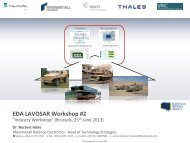capability development plan - European Defence Agency - Europa
capability development plan - European Defence Agency - Europa
capability development plan - European Defence Agency - Europa
Create successful ePaper yourself
Turn your PDF publications into a flip-book with our unique Google optimized e-Paper software.
48<br />
IMPACT OF SCIENCE AND TECHNOLOGY ON FUTURE<br />
CAPABILITIES DEVELOPMENT<br />
Conversely, HPM weapons, including improvised HPM charges, may pose a threat to our forces, both<br />
to C4ISR systems and to platforms. While it is a threat to our equipment rather than our troops,<br />
widespread disruption or destruction of electronics equipment could quickly translate into a loss of<br />
effectiveness and coherence that will lead to casualties in an operational environment. A reasonable<br />
resistance against HPM and some redundancy of systems will therefore be desirable.<br />
High-power laser weapons will mainly be used for ground- and sea-based air defence purposes<br />
against ballistic missiles and aerial platforms. The attractive aspect of laser weapons in comparison to<br />
surface-to-air missiles is that they are not dependent on a flight time to intercept. The practical range of<br />
such weapons, if they become medium- or long-range, will depend on what power level that can be<br />
implemented, the management of the laser beam (in terms of collimation and divergence) and if the<br />
problems of atmospheric disturbances can be managed.<br />
Laser weapons of somewhat lower power levels can be used to disrupt adversaries’ optical sensors in<br />
order to disrupt their ISTAR activities and weapons use. Due to the possibility of eye injury when<br />
directed against troops and manned platforms, there are some legal and ethical limitations to this use,<br />
which do not apply in the case of targeting missiles and unmanned vehicles used by adversaries.<br />
CBRN Exercise Jambes -<br />
Belgium 2008 © EDA<br />
Weapon systems – non-destructive and less lethal effects. As was noted above, directed energy<br />
weapons can be used for non-destructive/less lethal as well as destructive purposes, depending on the<br />
power level. Developments in information warfare have been covered previously.<br />
Developments in non- or less-lethal weapons, for use against personnel or equipment, depend on the<br />
use of several technologies, which from an S&T point of view are quite diverse and therefore need to<br />
be separately assessed. Some of the technologies that would produce the desired effects will not be<br />
possible to field because of legal or ethical considerations, such as the Chemical Weapons<br />
Convention. Some of the <strong>development</strong>s are civilian and are intended for use in law enforcement where<br />
ethical considerations also apply.<br />
CBRNE threats and protection. With regards to threats from non-conventional effects, civilian S&T<br />
<strong>development</strong>s may mean increased possibilities for adversaries. This will mainly affect the area of<br />
biological weapons, due to rapid advances in biotechnology, which may lead to weapons/agents that<br />
are very virulent, or which escape effective treatment or conventional means of early detection. While<br />
technological advances directly related to C, R and N threats may seem slower in comparison, we<br />
should not forget that civilian advances in production technology and computing, as well as the general<br />
proliferation of technological knowledge may bring various kinds of non-conventional weapons and<br />
their carriers within the reach of an increasing number of actors. However, an assessment of the future<br />
in-theatre CBRN threat must also take the will, ambition and level of resources of adversaries into<br />
account. Some adversaries are expected to be less constrained by ethical considerations, albeit not<br />
every potential adversary will necessary pursue CBRN weapons even if the technology exists.<br />
With respect to protection against CB attacks, S&T <strong>development</strong>s may provide some improvements<br />
with respect to protection equipment, decontamination and treatment of injures but primarily, S&T<br />
<strong>development</strong>s in the CBRNE protection area as a whole are related to detection and improved<br />
situational awareness. Here as for other threats, large number of networked sensors will provide the<br />
situational awareness. Also, it will be increasingly possible to perform stand-off CBE detection using<br />
lasers and other means of detection.<br />
The conventional and often asymmetric, threat from explosives (E) including IEDs has already been<br />
mentioned in connection with the protection needs of vehicles and soldiers. However, in terms of<br />
detection there are similarities between detection of many non-conventional threats and the detection<br />
of explosives. Therefore, the E area belongs together with at least C detection from a technological<br />
point of view, and also for E detection, increased standoff detection is expected. However, standoff<br />
detection will have limited sensitivity with respect to detection of “encased” explosives. Also, the rate of<br />
false alarms in CBRNE detection is likely to remain an issue, which means the situational awareness<br />
will be enhanced rather than complete.<br />
FUTURE TRENDS FROM THE CAPABILITY DEVELOPMENT PLAN

















